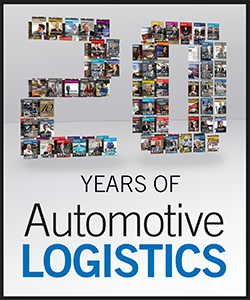A look at automotive packaging developments over the past 20 years
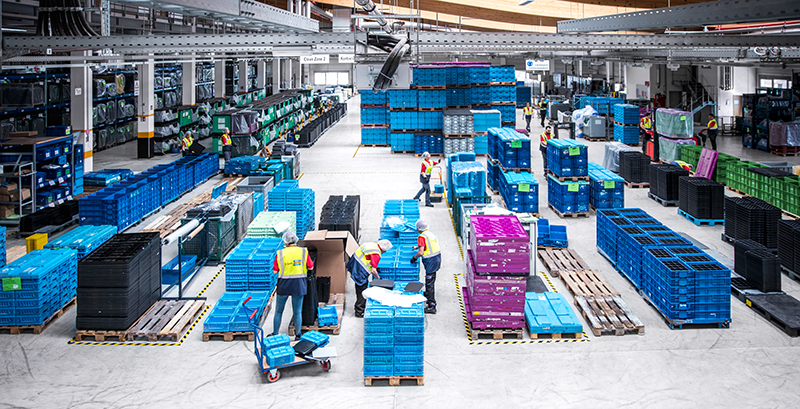 A lot has changed in logistics in the 20 years since Automotive Logistics first went to press. Thanks to the revolution of the information age, the world is more connected now than ever before. Shippers are delivering products faster than imagined. In the aftermarket, for example, more and more customers are receiving their goods and services same-day, regardless of location. And whether it is a factory, a dealership or perhaps even a consumer’s own home, demand for timeliness, efficiency and accuracy is rising constantly.
A lot has changed in logistics in the 20 years since Automotive Logistics first went to press. Thanks to the revolution of the information age, the world is more connected now than ever before. Shippers are delivering products faster than imagined. In the aftermarket, for example, more and more customers are receiving their goods and services same-day, regardless of location. And whether it is a factory, a dealership or perhaps even a consumer’s own home, demand for timeliness, efficiency and accuracy is rising constantly.
Such developments impact significantly on packaging, whether in facilitating an efficient transport flow, protecting goods or dealing with varieties of parts and delivery locations. In response, the automotive packaging industry now plays a much larger role in overall supply chain and distribution strategy than in the past. Packaging engineers and specialists have increased their focus on sustainability, ergonomics, workplace safety and the durability and quality of packaging, while also considering new options for change.
And for the future, no idea is too large or too challenging – from equipment that could be used for more than a decade to using digital technology and robots to transform how packaging is designed and handled. In fact, the evolution of automotive packaging – while certainly noticeable the last 20 years – may only be in its early stages.
A returnable, foldable revolutionAccording to Emmanuel Arnaud, executive vice-president for commerce and marketing at French logistics provider Gefco, which also manages returnable packaging for industrial clients, automotive packaging standards themselves haven’t evolved much over the last 20 years. Rather, new features like large, foldable, multi-purpose containers and multi-loop expandable containers have become increasingly popular.
Until the beginning of the 21st century, smaller packaging was essentially comprised of rigid boxes that were returned on a one-to-one basis. Since then, foldable packaging has become more popular, resulting in a return ratio that ranges from 1:3 to 1:7, decreasing return costs considerably.
“Large metal bins, which have a pallet-wide equivalent to 1 cubic metre, have been challenged by large, foldable plastic containers, which allow a more ergonomic design,” Arnaud says. “For instance, their windows open on the sides, so that operators’ picking process is much easier, and they have less long-term backaches.” Arnaud adds that multi-loop expandable containers can be reused several times, decreasing costs and waste compared to plastic boxes.
Peter Foot, marketing and innovation director for DS Smith UK’s industrial packaging division, agrees with Arnaud about the importance of increased safety and reducing waste, with sustainability rising to the top of the agenda over the last two decades. “As a result, packaging types are no longer mixed in order to aid reuse and recycling,” he states. “And there is now more of a focus on the entire supply cycle, along with a greater emphasis on the end user and how they access products safely and efficiently.”
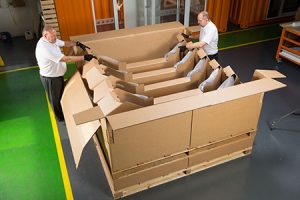 Despite the ability of stackable plastic containers to increase safety and eliminate cardboard dust, cardboard packaging still has its place
Despite the ability of stackable plastic containers to increase safety and eliminate cardboard dust, cardboard packaging still has its placeThe design, manufacturing and management of automotive packaging have improved significantly, both on the user and the provider side. This evolution has been especially noticeable in China, where, according to Vegard Synnes, head of key accounts at CDC International Logistics, the automotive industry was mostly focused on output, rather than supply chain optimisation, which left relatively little interest in returnable packaging usage.
“Today, packaging in China is evolving together with the industry. Technology is becoming better, and manufacturing techniques and packaging management are improving a lot,” he explains. “We even see several OEMs and tier suppliers establishing separate packaging departments, and specialists working exclusively with packaging. This was unheard of 20 years ago [in China].
“Simply put, the quality of packaging assets in China has improved immensely,” he adds. “Durability, design, quality, usability and standardisation are all at another level today.”
On the whole, experts report that OEMs have significantly increased their use of returnable packaging over one-way and disposable packaging in the past 20 years, particularly to reduce contamination from cardboard. As a result, parts are now better protected during handling, loading and stacking.
The use of high stackable containers has also helped to minimise product damage, which often occurred due to collapsed cardboard packaging.
“Cardboard dust had become a significant concern, so returnable packaging provides much more cleanliness,” says Martin Weiss, who was until recently director and head of corporate logistics for Mahle Behr. “It has also improved employees’ safety, as they no longer have to worry about being injured with cardboard knives while working in their plants.”
Since 1997, automotive packaging has also become much more efficient. It is, in general, lighter, and some new containers have larger usable volume and take up less space when empty than before, according to Roman Galuszka, business development manager for automotive at Schoeller Allibert. Consequently, companies can transport more parts per truck, as they also have a lower volume of empty packaging that they must either transport back and forth or keep in stock. Galuszka notes that optimised plastic, foldable containers, especially in recent years, have decreased packaging-related costs and CO2 emissions, while also improving cleanliness, workers’ safety and ergonomics.
“[As a result of a greater focus on sustainability] there is now more of a focus on the entire supply cycle, along with a greater emphasis on the end user and how they access products safely and efficiently.” - Vegard Synnes, CDC International Logistics
Nonetheless, unfoldable metal containers are still being used regularly. “Tier suppliers are still renting packaging for the wrong purposes,” he says. “This should be revised to decrease total packaging costs. For instance, they can start implementing more foldable, small containers, as they have better control over high volume and longer distance loops.”
Galuszka believes another trend may change soon: the development of packaging that only lasts for one model cycle (often 5-7 years) and is then scrapped afterwards.
“This should be divided and valid only for inlays, and external packaging should be used for at least 10-15 years, which will decrease packaging amortisation costs and reduce packaging capital expenditure significantly,” he explains.
Pooling risk and technologyVegard Synnes thinks that more tier suppliers are joining OEMs in using returnable packing due to the rising cost of expendable packaging, especially in China. An interest in multi-user pooling of equipment is also on the rise, with manufacturers turning to third-party providers and new IT systems to track and share equipment.
[mpu_ad]“To further improve packaging, there is a move towards more standardisation, in terms of packaging dimensions and functionality, as well as supporting systems for packaging activities,” he says. “There are also new ways of thinking about pooling. A cross-user, cross-provider type of pooling could go a long way in reducing waste in the returnable packaging sector.”
In addition to a rise in returnable packaging’s popularity, Rodney Salmon, a long-time packaging industry veteran who today runs his own packaging consultancy, agrees that the pooling of packaging among companies is on the rise in more countries, resulting in a more efficient supply, as well as an increase in standardisation.
“By using poolers or packaging manufacturers who offer a packaging tracking system, OEMs and tier suppliers will have more controlled supply chains, as less packaging is lost and used since the number of days is monitored,” he states. “Packaging not controlled in this way is liable to be lost and used in a more relaxed way, as nobody is taking responsibility.”
To successfully track packaging in the future, OEMs and tier suppliers must also hire packaging management experts who can control the data necessary to actively manage packaging pools. After all, a vast improvement in communications technology in the last 20 years has resulted in IT solutions that can provide the data base and transparency for adequate packaging pool management.
“Data is worthless if it isn’t monitored, analysed and interpreted,” says Ralf Manger, director of international subsidiaries and sales and marketing director for packaging specialist comepack. “To create a 100% valid and reliable packaging process, based on technologies like RFID, experts in technology and packaging processes are a must,” he states.
With this in mind, organisations like Brambles, which owns returnable packaging specialist Chep, are offering cloud-based logistics solutions that combine digital technologies with physical platforms, operations expertise and network scale. In doing so, they can provide real-time monitoring and analysis of asset tracking, inventory management and visibility into goods movement.
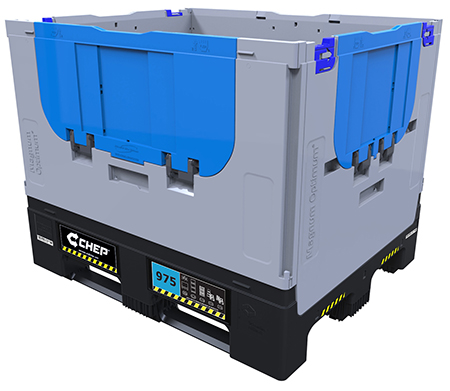 Cloud-based tracking and inventory management is increasingly being used to monitor packaging flows, reducing cost and improving efficiency
Cloud-based tracking and inventory management is increasingly being used to monitor packaging flows, reducing cost and improving efficiency“Furthermore, by using a variety of device technologies to provide a range of data acquisition capabilities, customers can extract insights to make proactive decisions,” says Vanessa Stark, director of strategic marketing at Chep. “With digital technologies, fully integrated with shipping platforms, operations and business processes, customers can experience seamless operations to leverage a more connected, intelligent and efficient supply chain.”
One way can still be the right wayWhile there has been considerable focus on returnable and standard equipment, over the last 20 years expendable packaging solutions have also become more robust. To meet next-day and same-day delivery needs for service parts, for example, as well as to minimise storage space requirements, some packaging specialists have offered OEMs more ‘on-demand’ formats, since using returnable equipment for these flows isn’t always feasible.
Expendable packaging has also become more sustainable, a factor that Ben Nguku, transportation sector marketing manager for packaging specialist Sealed Air, believes will become even more important in the future.
“The solutions need to have the end consumer in mind. We have to ask ourselves how they will receive the product, what they will do when they unbox it and what they will do with the waste,” he explains. “Can the materials be easily reused or recycled, or will they end up in landfill? And what is the real environmental cost of the solution from cradle to grave?”
Nguku also thinks e-commerce will have a considerable influence on the expendable packaging market in coming years for automotive spare parts. Hedges & Company, a marketing research firm, reports that e-commerce automotive parts sales are already higher than bricks-and-mortar sales, and may rise to nearly $9 billion this year.
Therefore, OEMs must focus on brand enhancement. If in future, for example, original OEM parts will be delivered directly to consumers’ doorsteps, as opposed to through dealers or distributors, OEMs have to consider the unboxing and packaging disposal experience as a part of their offering.
“Packaging engineering teams will need to adapt to account for marketing input, in addition to product protection, dimensional and weight issues and productivity,” Nguku adds, suggesting that packaging specialists have a big role to play in helping OEMs both in efficiency and customer experience.
Packaging 4.0Ultimately, the automotive supply chain in the coming decade and beyond may require a very different approach to packaging, even compared to the strides made up to now. Rodney Salmon, who is currently consulting for packaging provider Macro Plastics, projects the number of automotive parts that need packaging will decline by 50%, as hybrids and electric vehicles become more and more popular. Consequently, packaging suppliers will need to rethink their supply methods.
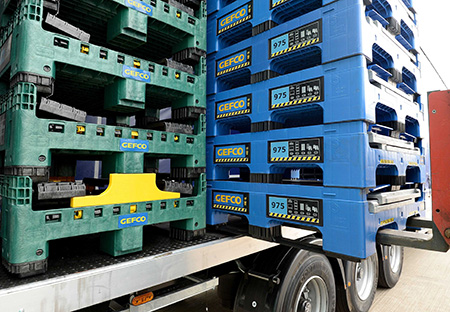 Packaging design will evolve to complement the use of automated guided vehicles and faster truck loading and unloading
Packaging design will evolve to complement the use of automated guided vehicles and faster truck loading and unloadingTo overcome this issue, OEMs and tier suppliers may go further with packaging standardisation, suggests Salmon. By using the same packaging for similar parts, tier suppliers would be able to ease their handling and storage processes, as they supply parts to various OEMs. Another option is the use of “one-way plastic” packaging, which Salmon admits can be viewed as an oxymoron by some automotive professionals.
“This type of packaging uses plastic to pack parts from the tier supplier into the OEM, and then collects the plastic packaging when empty from the OEM, prior to re-grinding or recycling it and sending it back to the packaging supplier to make more packaging out of,” Salmon says. “And, perhaps best of all, it can all be achieved at a similar cost to using cardboard or wood.”
As OEMs and tier suppliers prepare for the future of parts packaging, the complexity of long distance supply chains, regardless of transport mode, can’t be underestimated. Not only do they influence the cycle time of packaging, but they also require higher transport utilisation to control shipping costs, according to Ralf Manger at comepack. “This leads to the necessity of service centre networks and consolidation points for packaging in order to continuously reposition it in the right time and right place,” he states.
Because of their long-distance supply chains, Chep’s Vanessa Stark also advises OEMs and tier suppliers to consider outsourcing non-core activities like packaging management. If they choose to completely control their own assets and supply chains instead, they may encounter unexpected costs.
“The fact that some companies compare the price of a cardboard box to the depreciation of a reusable asset, without considering the total cost of ownership, may lead to unexpected costs like extra asset purchases during peak production, maintenance and washing of equipment, and spare parts purchasing,” she explains.
“It may seem like an ‘add-on’ activity for a large-scale OEM or tier supplier, but – owing to the ever-increasing complexity of supply chains – packaging management can cause a whole host of unwanted, hidden costs across several departments.”
“We have to ask ourselves how [the end consumer] will receive the product, what they will do when they unbox it and what they will do with the waste. Can the materials be easily reused or recycled, or will they end up in landfill?” - Ben Nguku, Sealed Air
Increasing automation and digitalisation will also impact on the way the automotive industry designs, builds and uses certain packaging equipment, according to Boris Dul’a, chief executive and chairman of the board for Slovakia-based technology and manufacturing equipment specialist CEIT. As well as tagging equipment for tracking as standard for ‘smart packaging’, he predicts automotive packaging will need to fit requirements for placing pallets within robotic workplaces, for example. He anticipates that packaging will have a different type of design to allow for more automated guided vehicle transport in factories and warehouses, as well as quick truck loading and unloading. He also foresees manufacturers using digital systems and planning tools more to improve the use of construction materials and transport space.
While automotive packaging will inevitably depend on the requirements of carmakers and their production and distribution strategies, the role of packaging expertise and knowhow is likely to increase, particularly as equipment and processes become more high-tech, or supply chains become even more complex and global. Perhaps only one thing is for sure: don’t expect one box to contain all the answers.

























![Global[1]](https://d3n5uof8vony13.cloudfront.net/Pictures/web/a/d/s/global1_726550.svgz)





